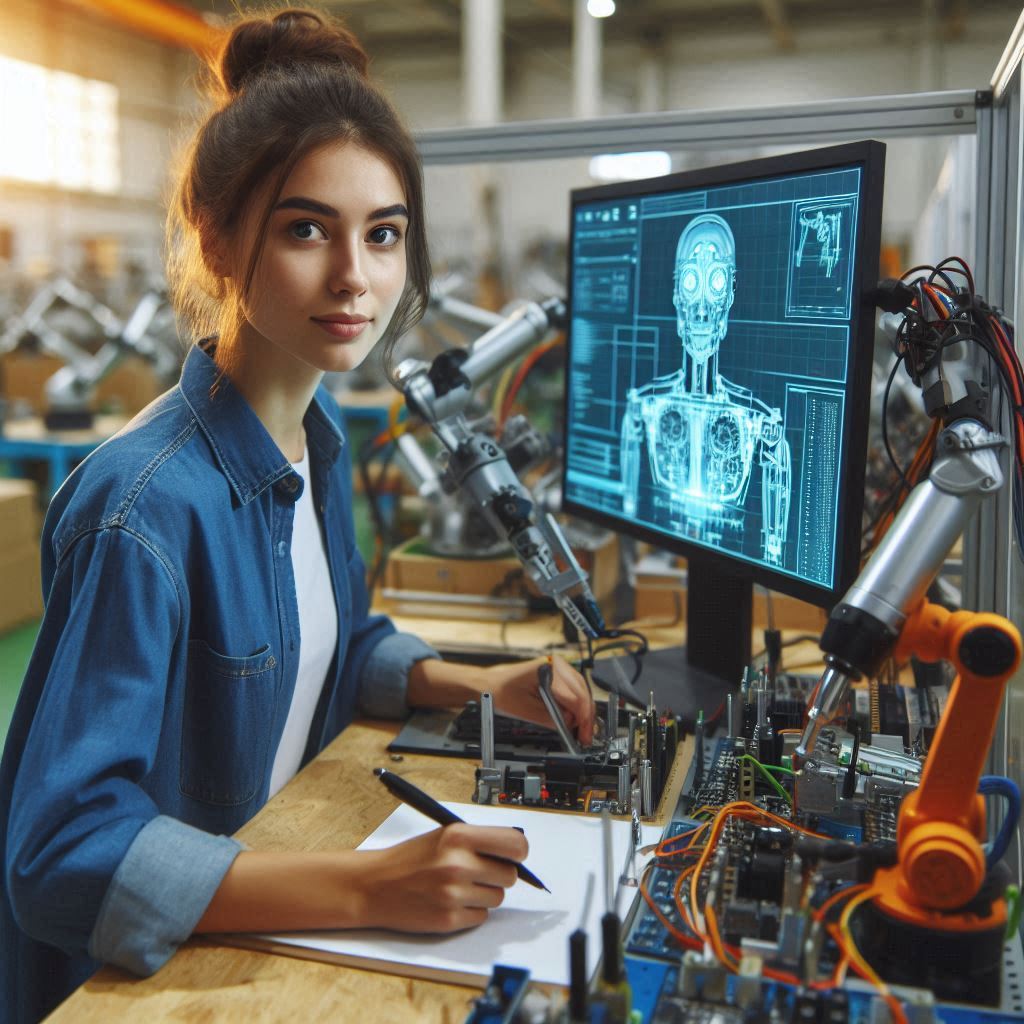Introduction
Robotics technology has seen remarkable advancements in recent years.
These innovations are transforming various industries, from manufacturing and healthcare to defense and space exploration.
The field of robotics is evolving rapidly, driven by advancements in artificial intelligence, machine learning, and material science.
Robotics technology is rapidly growing, reshaping how businesses operate and transforming task performance.
Automated systems are improving efficiency, precision, and safety across multiple sectors.
Robots now enhance assembly lines in manufacturing, perform surgeries in healthcare, and conduct reconnaissance missions in defense.
Keeping up with the latest developments in robotics technology is crucial.
Staying informed about new advancements allows businesses and professionals to leverage the latest tools and techniques.
This approach maintains a competitive edge and fosters innovation.
As robotics evolves, it will impact industries and daily life more profoundly. Staying updated on trends and breakthroughs is essential.
History of Robotics Technology
Overview Of The History Of Robotics Technology
- Robotics technology has a rich history dating back to ancient times.
- Early automata and mechanical devices were precursors to modern robotics.
- Key figures like Leonardo da Vinci and Hero of Alexandria made significant contributions.
- The Industrial Revolution saw the development of mechanized devices for automation.
- The term “robot” was first coined by Czech playwright Karel Capek in 1920.
Key Milestones in the Evolution of Robotics
- In 1954, George Devol and Joseph Engelberger created the first industrial robot.
- The space race in the 1960s led to advancements in robotic technology for space exploration.
- The 1980s saw the introduction of robotic arms for manufacturing processes.
- Advances in artificial intelligence in the 1990s enabled more sophisticated robots.
- Recent years have seen the rise of autonomous robots for various applications.
How Far Robotics Technology Has Come
- From simple automata to advanced humanoid robots, the evolution has been remarkable.
- Rapid advancements in sensors, actuators, and AI have enhanced robot capabilities.
- Industries such as manufacturing, healthcare, and agriculture now use robots extensively.
- The integration of robotics with other technologies like IoT and big data is expanding possibilities.
- The future of robotics technology looks promising with ongoing research and development.
Read: Top Companies Hiring CAD Technicians in the USA
Applications of Robotics Technology
Robotics technology revolutionizes numerous industries.
Robots boost productivity, efficiency, and accuracy in diverse tasks.
Each industry leverages these capabilities to enhance performance.
Let’s explore how robots are making an impact in sectors like healthcare, manufacturing, agriculture, and logistics.
Healthcare Industry
In the healthcare sector, robots are playing a crucial role in advancing medical practices and providing better patient care.
One of the key areas where robotics technology has made significant strides is in surgical procedures.
The Da Vinci Surgical System is a prime example of how robots are transforming the field of surgery.
This robotic system enables surgeons to perform complex operations with enhanced precision, minimal invasiveness, and improved outcomes for patients.
Moreover, healthcare professionals now use robots in radiology for diagnosing and treating diseases.
Radiology robots help in conducting accurate scans, analyzing images, and planning treatments, ultimately leading to better patient care and treatment outcomes.
Manufacturing Sector
One of the earliest adopters of robotics technology, the manufacturing industry has seen significant advancements in automation and robotics.
Industrial robots are now a common sight on manufacturing lines, where they handle repetitive tasks with speed, precision, and consistency.
Collaborative robots, or cobots, have revolutionized manufacturing by allowing humans and robots to work together safely and efficiently.
Cobots assist workers in tasks that require strength, precision, or repetition, leading to improved productivity and workplace safety.
Agricultural Applications
Robots streamline farming operations, boost crop yields, and optimize resource use in agriculture.
Autonomous drones equipped with sensors and cameras monitor crops, control pests, and plant seeds with precision.
Robotic harvesters have also made significant contributions to agriculture by automating the labor-intensive process of picking fruits and vegetables.
These robots can harvest crops faster, more efficiently, and with reduced wastage, resulting in cost savings for farmers and improved supply chain logistics.
Logistics and Warehousing
Robots are reshaping the way goods are stored, picked, packed, and shipped in logistics and warehousing facilities.
Automated guided vehicles (AGVs) are used to transport goods within warehouses, increasing efficiency and reducing manual labor in inventory management.
Robotic arms use sensors and computer vision to pick, pack, and prepare orders for shipping in fulfillment centers.
These robotic systems operate with speed, accuracy, and reliability, enabling e-commerce companies to fulfill orders swiftly and deliver products on time.
In fact, robotics technology is revolutionizing various industries by enhancing operational efficiency, accuracy, and productivity.
As robots evolve and advance, they will drive innovations across various fields.
This progress will reshape the future of work and industry.
Read: How to Build a Strong CAD Technician Portfolio
Emerging Trends in Robotics
Robotic technology is continuously evolving, with several emerging trends reshaping the landscape of robotics.
These trends are at the forefront of innovation, driving advancements in artificial intelligence, machine learning, and automation.
Artificial Intelligence in Robotics
- Artificial intelligence is revolutionizing robotics, enabling machines to learn from data and perform tasks with human-like precision.
- AI-powered robots are capable of making decisions autonomously, adapting to new situations, and improving their performance over time.
- The integration of AI algorithms in robots allows them to interact with their environment intelligently and perceive complex information.
- Advancements in deep learning and neural networks have enhanced the capabilities of robots, making them more efficient and versatile in various applications.
Machine Learning Advancements
- Machine learning plays a crucial role in robotics by enabling robots to analyze data, recognize patterns, and make informed decisions.
- Robots equipped with machine learning algorithms can continuously improve their performance through experience, feedback, and self-correction.
- Supervised and unsupervised learning techniques are being utilized to train robots for different tasks, such as object recognition, navigation, and manipulation.
- Reinforcement learning has emerged as a powerful tool for training robots to achieve goals and learn complex behaviors in dynamic environments.
Automation Trends
- Automation in robotics is driving efficiency and productivity across various industries, streamlining processes and reducing manual labor.
- Rapid advancements in automation technology have led to the development of robotic systems that can perform repetitive tasks with high accuracy and speed.
- Collaborative robots, or cobots, are being integrated into workplaces to work alongside humans, enhancing safety and productivity on the factory floor.
- Robotic process automation (RPA) is automating rule-based tasks in business processes, optimizing workflows and freeing up human resources for more strategic activities.
These trends in robotics are shaping the future of technology, with a focus on creating smarter, more autonomous, and efficient robots.
As artificial intelligence, machine learning, and automation continue to advance, the possibilities for robotics applications are limitless.
Read: Best Online Courses for CAD Technician Training
Challenges in Robotics Technology
Safety Concerns
One of the primary challenges in robotics technology is ensuring the safety of both humans and robots in various environments.
As robots work closer to people, concerns about accidents and injuries rise.
Proper safety measures must be in place to prevent these risks.
Researchers and industry experts are focusing on developing advanced sensors and algorithms to enable robots to detect and avoid potential hazards.
Ethical Considerations
Another critical challenge in robotics technology is addressing the ethical implications of using robots in society.
Job displacement, privacy concerns, and autonomous decision-making highlight the ethical responsibilities of robotics developers and users.
Researchers are incorporating ethical frameworks into robot design and programming.
They aim to ensure robots follow moral principles and societal norms.
Regulatory Hurdles
Regulatory challenges pose a significant barrier to the widespread adoption of robotics technology.
Different countries enforce varying laws and regulations on robotics use in industries.
These differences can delay deployments and limit robotics benefits.
Researchers and industry experts are working with policymakers.
They aim to develop unified standards and guidelines for the safe, ethical use of robots across sectors.
In essence, the challenges facing the development of robotics technology are complex and multifaceted.
Ongoing research and collaboration among stakeholders can effectively address these challenges.
This approach will harness robotics technology‘s full potential, creating a safer, more efficient, and ethical future.
Read: Future of CAD Technician Jobs in Engineering

Innovations in Robotics Technology
Cutting-Edge Innovations in Robotics
Robotics technology is rapidly evolving, pushing the boundaries of what robots can achieve.
Key innovations are transforming robotic hardware, software, and design.
Advancements in Robotic Hardware
Recent advancements in robotic hardware focus on enhancing mobility and dexterity.
For example, Boston Dynamics’ Atlas robot showcases exceptional agility and balance.
It performs complex movements such as parkour and backflips, demonstrating significant improvements in robot locomotion.
Breakthroughs in Robotic Software
Software advancements have revolutionized how robots perceive and interact with their environment.
Machine learning algorithms enable robots to learn from their surroundings and improve their performance over time.
An example is the NVIDIA Isaac SDK.
It equips developers with powerful tools.
These tools help create intelligent robotic systems.
The systems can perform real-time perception and decision-making.
Innovations in Robotic Design
Robotic design is also advancing, with new materials and structural concepts improving robots’ functionality and durability.
Soft robotics is a prime example, where robots made from flexible materials can navigate delicate environments and interact with humans safely.
The Soft Robotics Inc.’s gripper, for instance, can handle fragile objects with precision, demonstrating the advantages of soft robotic design.
Groundbreaking Robotic Technologies
Several groundbreaking technologies are pushing the limits of robotics.
One notable example is the development of autonomous drones used for delivery and inspection tasks.
Companies like Zipline use drones to deliver medical supplies to remote areas, showcasing the potential of robotics to solve real-world problems.
Additionally, robotics exoskeletons are transforming human capabilities.
The ReWalk exoskeleton helps individuals with spinal cord injuries regain mobility, highlighting how robotics can significantly impact quality of life.
Innovations in robotics technology are driving remarkable progress across hardware, software, and design.
These advancements are expanding the possibilities of what robots can achieve, from enhanced mobility and intelligent interaction to new applications in various fields.
As technology continues to evolve, robotics will likely play an increasingly integral role in both industry and daily life.
Transform Your Career Today
Unlock a personalized career strategy that drives real results. Get tailored advice and a roadmap designed just for you.
Start NowFind Out More: Common Challenges in Biomedical Technician Jobs
Explore Further: Industrial Machinery Mechanic Job Interview Tips
Impact of Robotics Technology on Society
The Potential Impact Of Robotics Technology On Society As A Whole
Robotics technology has the potential to significantly impact society in various ways, both positive and negative.
Here are some key points to consider:
How Robotics Technology Is Creating New Job Opportunities While Also Displacing Certain Types Of Jobs
- Robotics technology is creating new job opportunities in industries such as manufacturing, healthcare, and logistics.
- There is a growing demand for skilled workers who can design, program, and maintain robots.
- Jobs related to robot maintenance, software development, and robot supervision are on the rise.
Displacement of Certain Types of Jobs
- While robotics technology is creating new job opportunities, it is also displacing certain types of jobs.
- Tasks that are repetitive and routine in nature are being automated, leading to job loss for some individuals.
- Workers in industries like manufacturing and retail may face job displacement due to automation.
Ethical Concerns
- There are ethical concerns surrounding the use of robots in everyday life, especially in sensitive areas like healthcare and security.
- Issues related to privacy, safety, and autonomy need to be carefully considered when deploying robots in society.
- There is a fear of robots replacing human interaction, leading to social isolation and diminishing empathy.
In general, while robotics technology offers numerous benefits and advancements, it is crucial to address the societal impact it may have.
By addressing ethical concerns and seizing new job opportunities, society can leverage robotics technology to improve humanity.
See Related Content: Top Industries Hiring Cybersecurity Analysts in 2024
Conclusion
Throughout this blog post, we‘ve delved into the transformative impact of robotics across multiple industries.
Robotics is redefining traditional practices across industries.
It enhances efficiency and pushes the boundaries of what is possible.
From manufacturing to healthcare and space exploration, robotics drives innovation and transformation.
We explored how automation is revolutionizing assembly lines, improving precision in medical procedures, and enabling the exploration of distant planets.
Additionally, we touched on the potential challenges posed by robotics, such as job displacement and the ethical considerations surrounding automation.
A key takeaway from our discussion is the importance of collaboration between robotics engineers and professionals in other fields.
Collaborating with healthcare providers drives the development of cutting-edge surgical robots.
Partnering with aerospace experts builds autonomous space rovers.
Interdisciplinary cooperation is crucial for success.
This collaboration not only drives innovation but also ensures that the implementation of robotics technology is safe, ethical, and effective.
Essentially, as we move forward into an increasingly automated world, the role of robotics will only grow in importance.
Stay informed and engaged to adapt to these changes. Drive the innovations shaping the next generation of technology.
The future of robotics is bright, and those who stay ahead of the curve will be well-positioned to reap the benefits.




